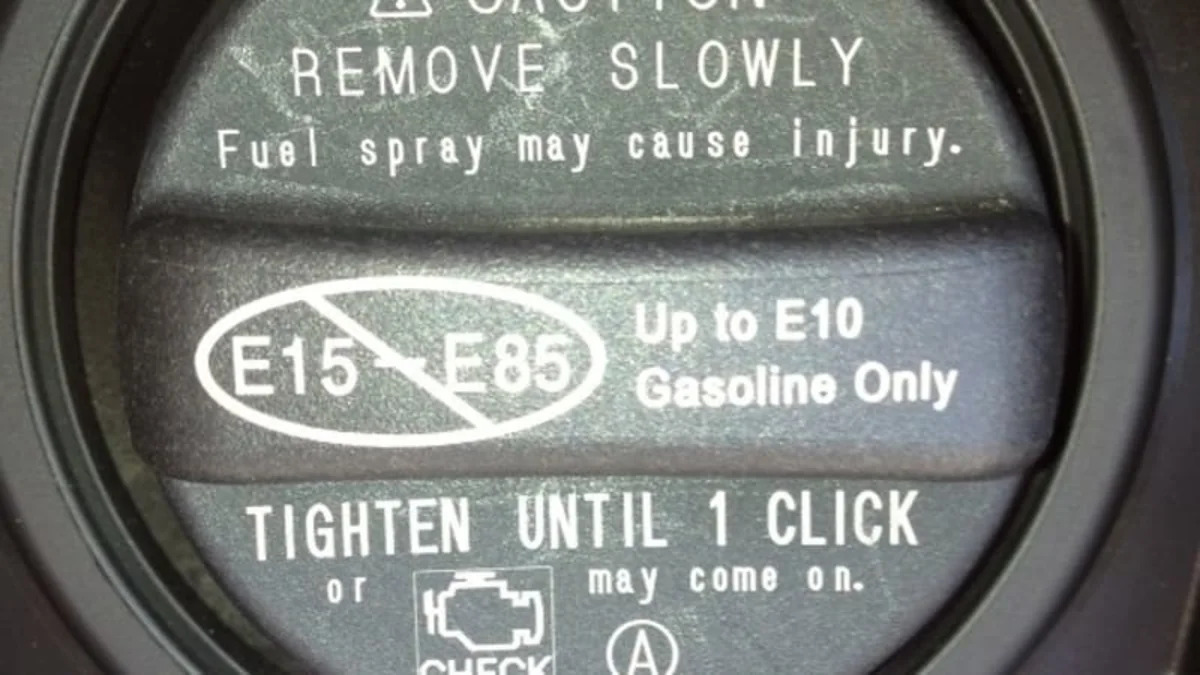For some drivers, ethanol-blended fuels such as E15 and E85 generate the same kind of confusion as stalactites and stalagmites do for high school geography students. Now, E15, which is fuel sold with a 15 percent blend of ethanol, is creating confusion all on its own.
That's what the Minneapolis Star Tribune is reporting now that many gas stations are on the verge of adding so-called "blender pumps" that can distribute E15. While the pumps will have a government warning saying E15 can be used for cars made after the 2000 model year, automakers aren't so clear. Toyota and Lexus, for example, say on their model-year 2012 gas caps that E15 shouldn't be used (pictured), and Ford is also warning its customers against using E15.
Iowa and Kansas are states where E15 may be sold as soon as this month, Bob Dinneen, the CEO of ethanol trade group Renewable Fuels Association, told the Tribune. Dinneen called E15, "probably the single most studied fuel in the history of EPA waivers." But then there's the Alliance of Automobile Manufacturers, which represents Ford, General Motors and Chrysler, among other automakers and says E15 hasn't been adequately tested.
Last month, the U.S. Environmental Protection Agency (EPA), as expected, approved the first applications to produce E15, which can be made with as much as 50 percent more ethanol than standard fuel, which so far has been limited to 10 percent ethanol. Automakers and recreation vehicle makers are among the entities that have fought against allowing widespread use of E15, claiming that the higher alcohol content may damage engines and fuel systems. Still, the government continues to push ethanol as a way to cut foreign-oil dependence, even though last year U.S. Congress terminated a 30-year tax subsidy on corn-based ethanol. The ethanol industry received an estimated $45 billion in subsidies since 1980.
That's what the Minneapolis Star Tribune is reporting now that many gas stations are on the verge of adding so-called "blender pumps" that can distribute E15. While the pumps will have a government warning saying E15 can be used for cars made after the 2000 model year, automakers aren't so clear. Toyota and Lexus, for example, say on their model-year 2012 gas caps that E15 shouldn't be used (pictured), and Ford is also warning its customers against using E15.
Iowa and Kansas are states where E15 may be sold as soon as this month, Bob Dinneen, the CEO of ethanol trade group Renewable Fuels Association, told the Tribune. Dinneen called E15, "probably the single most studied fuel in the history of EPA waivers." But then there's the Alliance of Automobile Manufacturers, which represents Ford, General Motors and Chrysler, among other automakers and says E15 hasn't been adequately tested.
Last month, the U.S. Environmental Protection Agency (EPA), as expected, approved the first applications to produce E15, which can be made with as much as 50 percent more ethanol than standard fuel, which so far has been limited to 10 percent ethanol. Automakers and recreation vehicle makers are among the entities that have fought against allowing widespread use of E15, claiming that the higher alcohol content may damage engines and fuel systems. Still, the government continues to push ethanol as a way to cut foreign-oil dependence, even though last year U.S. Congress terminated a 30-year tax subsidy on corn-based ethanol. The ethanol industry received an estimated $45 billion in subsidies since 1980.


Sign in to post
Please sign in to leave a comment.
Continue